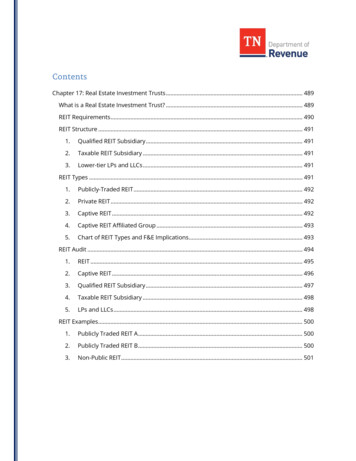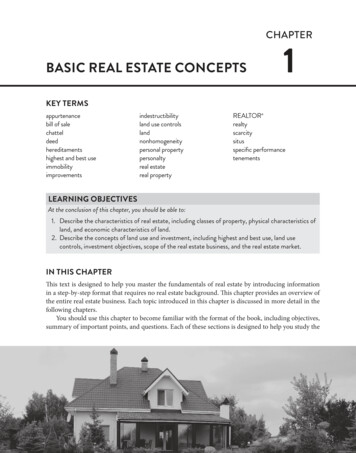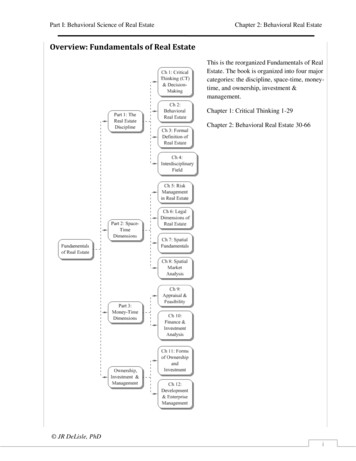
Transcription
Passive and Real Estate ActivitiesPassive andReal EstateActivitiesIf you are an owner of a business in which you do not materiallyparticipate, the passive activity rules can limit your ability to deductlosses. And, if you hold rental real estate investments, the losses are passiveeven if you materially participate, unless you qualify as a real estateprofessional. Income from passive activities including rental real estate mayalso be subject to the 3.8% Medicare Contribution Tax on net investment income.RETURN TO TOC65
EisnerAmper 2020 Personal Tax Guide What are Passive Losses?forward to the following year, subject to the samepassive loss rules and limitations.A passive loss is a loss from a business activity in whichyou do not materially participate. The most commonways you are deemed to materially participate in abusiness activity, and thereby avoid the passive activitylimitation rules, are if:Taxpayers should keep detailed records as to the timethey spend on a particular activity, especially whenthey participate in several activities. Moreover, thereare specific rules as to what kind of work qualifies asparticipation. Y ou participate more than 500 hours in the activityduring the year, Convert Passive Losses Y our participation constitutes substantially all of theparticipation in the activity,If you fail the material participation tests and you havepassive losses that are subject to a disallowance, thereare things that you can do to convert the disallowedlosses into tax-saving deductible losses: Y ou work more than 100 hours per year in the activityand not less than any other person, including nonowners, orDispose of the activitySell any passive activity with current or suspendedpassive losses through a bona fide sale to an unrelatedparty. The losses become fully deductible when theactivity is sold – including any loss on the disposition(subject to capital loss limitations). Even if you realizea gain on the sale, you can still save taxes as Tax Tip 13illustrates. But you must also be aware of the phantomincome trap discussed in Tax Tip 14. Y ou work more than 100 hours per year in each ofseveral activities, totalling more than 500 hours peryear in all such activities.Passive activity losses are deductible only to the extentthat you have income from other passive activities tooffset the losses, or when you completely dispose ofthe activity. If you have passive losses that you cannotdeduct in the current year, you can carry these lossesTax Tip13. Use Passive Activity Capital Gains toRelease Suspended Ordinary LossesIf you have suspended passive activity losses, you may be ableto dispose of a passive activity at a gain and not have to pay anytaxes. In fact, you may actually reduce your taxes despite the gain.As an example, assume you have suspended passive losses of 300,000 from an activity that you have held for more than oneyear. You dispose of the activity in 2019 and realize a capital gainof 340,000. You would actually save federal taxes of 43,000 aswell as receiving the proceeds from the sale.This very favorable result is due to the fact that the suspendedlosses reduce your ordinary income at a 37% rate (beginning onJanuary 1, 2018), whereas the long-term capital gain from the salewould be taxed at no more than 20%. The suspended loss wouldtherefore reduce your tax by 111,000 (37% of 300,000), but thecapital gain would only increase your tax by 68,000 (20% of 340,000). If you have a net capital loss carryover that you mightbe able to utilize, your savings would even be greater since thegain could be offset by the carryover loss, giving you the full taxbenefit of the loss (but a reduced carryover).The tax savings would be reduced by the 3.8% MedicareContribution Tax in the amount of 1,520 (3.8% of 40,000, whichis the difference between the 340,000 capital gain and 300,000ordinary loss).RETURN TO TOC66
Increase the hours you participate in realproperty trades or businessesIf you are engaged in real estate activities, increaseyour hours to meet the real estate professional test(discussed below). If you are a real estate professional,your real estate losses are no longer treated as passivelosses, allowing you to deduct them in full. Utilize Your Passive LossesIf you have passive losses from activities that youcannot convert into “material participation” activitiesas discussed above, you should consider taking thefollowing steps to utilize your passive losses:Decrease your participation in income activitiesFor an activity in which you materially participate that isgenerating non-passive income, limit your participationto less than 500 hours, if feasible. Therefore, the activitymay become passive and you can use the income tooffset your passive losses. However, make sure that youare not still considered active under the other tests. Thismay result in the additional 3.8% Medicare ContributionTax to the extent that the income is not fully offsetby passive losses. If you or your spouse have beenmaterially participating in the activity for five out ofthe last ten years, you will be deemed to be materiallyparticipating in the current year, even if you do notparticipate at all in the current year.Invest in income-producing passive activitiesConsider investing in an income-producing trade orbusiness that you will not materially participate in. Thiscreates passive income to you which can be offsetuntil you utilize all of your passive losses from otherunrelated passive activities. This may result in theadditional 3.8% Medicare Contribution Tax to the extentthat the income is not fully offset by passive losses.Tax Tip14. The PhantomIncome TrapIncome in excess of your net proceeds can be triggered upon thedisposition of real estate. This results from prior deductions basedon indebtedness. Therefore, you may have deducted losses and/orreceived cash distributions in prior years that were greater than youractual investment in the property. This is sometimes referred to asnegative capital.Phantom income to the extent of your negative capital can also occurif you dispose of your interest in the pass-through activity, even if theunderlying property remains unsold. However, to the extent your prioryear’s passive losses were suspended, you would have an ordinary lossto offset this income. As Tax Tip 13 demonstrates, this can actually be atax savings opportunity. Identify Your Actual Passive LossesWhen identifying your net passive losses, take intoaccount the following: I nvestment and trading partnerships, S corporationsand LLCs that only generate portfolio income, such ascapital gains, interest and dividends, are not passiveactivities, even if you do not participate in the activity.Therefore, the investment income cannot offset yourpassive losses. I nterest expense on money borrowed to fund yourinvestment in a passive activity is treated as anadditional passive activity deduction, subject to thesame disallowance rules. P ortfolio income, such as interest and dividends, froma passive activity cannot offset the passive losses fromthe activity. L osses from Limited Liability Companies(“LLCs”) and Limited Liability Partnerships(“LLPs”)Generally, limited partners of an LLP are presumed tonot be materially participating in the business, and thusRETURN TO TOC67Passive and Real Estate ActivitiesIncrease your participation in loss activitiesFor an activity that is generating losses, considerincreasing your participation to meet one of the testslisted above, if possible, so you will not be subject to apassive loss limitation for the activity in that year.
EisnerAmper 2020 Personal Tax Guidethese activities would be considered passive. Thereis an exception to the presumption of no materialparticipation where an individual holds an interest ina limited partnership as both a limited partner and ageneral partner. In this case, such person can avoid thepassive loss rules with respect to the limited partnershipinterest.The courts have addressed whether the rules that applyto limited partnership interests also apply to membersof an LLC. Although the IRS does not concur, caseshave held that such members are not limited partnersfor purposes of determining their material participationin these activities. Rather, the facts and circumstancesmust be examined to ascertain the nature and extent ofthe participation of the member.Limitation on Losses for Taxpayers Other ThanCorporationsUnder the passive activity loss rules contained in IRCSec. 469, if a taxpayer has a flow-through loss from apassive activity, the passive loss could not offset earnedincome or ordinary income at the individual taxpayerlevel. The passive loss rules prevent taxpayers fromusing losses incurred from income-producing activitiesin which they are not materially involved. However, ifthe taxpayer is a real estate professional, the lossesderived from real estate activities are not consideredpassive and are available to offset all categories ofincome, including earned income or ordinary income.The TCJA amends and adds to IRC Sec. 461 anadditional limitation on a taxpayer’s business loss fromentities other than C corporations, called an “excessbusiness loss” limitation, effective for taxable yearsbeginning after December 31, 2017. The TCJA definesan excess business loss as the excess of aggregatedeductions of the taxpayer attributable to his or hertrade or business over the sum of aggregate grossTax Tip15. Defer Your Gain Using the InstallmentSale MethodIn 2019, you sell a nonresidential building for 2,000,000, net of closing costs, which you bought in 1998 for 600,000 (including subsequentimprovements). At the time of the sale, you had accumulated depreciation of 400,000. Therefore your taxable capital gain is 1,800,000( 2,000,000 less the cost of 600,000 plus the accumulated depreciation of 400,000). You will receive a 20% down payment of 400,000before the end of the year and receive a mortgage from the buyer for the balance, with the first payment due in January of 2020. By usingthe installment sale method, you will defer 290,000 of federal tax to future years as the mortgage is paid down by the buyer.Full payment in current yearInstallment sale method 1,800,000 360,000380,00090,000Taxable gain in year of saleFederal tax cost this yearDeferred tax290,000The taxable gain using the installment sale method is computed by multiplying the down payment of 400,000 by the gross profitratio of 90%. The gross profit ratio is the taxable gain of 1,800,000 divided by the total proceeds of 2,000,000.Caution: You are subject to a tax rate of 25% on the portion of the gain that is attributable to previous non-accelerated depreciationdeductions on real property on a “first in first out” (“FIFO”) method. Also, this method may not be advantageous when the tax rates offuture years’ installments are expected to increase.Note: The 3.8% Medicare Contribution Tax on net investment income, which is not reflected in the above illustration, may apply to thegain and related interest.RETURN TO TOC68
P assive Activity CreditsTax credits from passive activities, such as rehabilitationand low-income housing credits, can reduce yourregular tax liability. However, for properties placed intoservice prior to 2008, these credits are limited to theamount of your regular tax attributable to your netpassive income, and cannot be used to reduce yourAMT. For post-2007 investments, both the qualifiedRehabilitation Tax credit as well as the low-incomehousing credit can offset both regular tax and AMT tothe extent of your tax attributable to passive activityincome. If you have a net overall passive loss, thedisallowed credits are carried forward and can be usedto offset your taxes in future years. If you have netpassive income but the credits are limited because ofthe AMT, you can carry the credits forward to offset yourregular tax in future years when you are not in the AMT.activity. This special allowance is reduced, but not belowzero, by 50% of the amount by which the taxpayer’s AGIexceeds 100,000. It is completely phased out when AGIreaches 150,000. Real Estate Professional RulesIf you are a real estate professional, you can deductrental real estate losses in full since you are not subjectto the passive loss limitations. To qualify, you mustannually: P erform more than 50% of your personal servicesin real property trades or businesses in which youmaterially participate, and H ave more than 750 hours of service in thesebusinesses.In addition, you must materially participate in therental real estate activity in order for that activity to beconsidered nonpassive. For example, a real estate brokerwho owns one or two apartments for rent might be areal estate professional but might not be considered tomaterially participate in the rental activity.In the case of a joint return, the real estate professionalrequirements are satisfied if, and only if, at least one ofthe spouses separately satisfies both requirements. Inregards to the material participation test though, workperformed by a taxpayer’s spouse in a trade or businessis treated as work performed by the taxpayer. Real Estate ActivitiesReal estate professionals are not subject to the 3.8%Medicare Contribution Tax on net investment income,including capital gains, from rental real estate activities inwhich they materially participate.Real estate activities are passive by definition, unlessyou qualify as a real estate professional. Regardless ofwhether you are a real estate professional or not, thereare ways you can defer the tax from the gain on the saleof real estate properties, as discussed below. A separaterule allows you to deduct up to 25,000 of losses eachyear if you actively participate in a rental real estateObservation: If you fail either test and you have realestate losses, try to increase your hours of service to meetthe tests. For purposes of the real estate professional test,a taxpayer can elect to aggregate all of their real estaterental activities to determine material participation. Oncethe election is made, it continues unless the IRS consentsto its revocation.RETURN TO TOC69Passive and Real Estate Activitiesincome or gain for the taxable year plus a thresholdamount of 500,000 for married taxpayer filing jointlyor 250,000 for all other taxpayers. The thresholdamounts will be adjusted for inflation every year, andthis limitation expires after December 31, 2025. Anyresidual amounts are treated as an NOL carryforwardfor the taxpayer in the following years in accordancewith IRC Sec. 172. The TCJA has amended the NOLcarryforward to be indefinite and limits the NOLdeduction to 80% of taxable income for a given taxableyear. When applying the NOL deduction in subsequentyears, the taxpayer will need to follow the orderingrules per IRC Sec. 172.
EisnerAmper 2020 Personal Tax Guide Installment Sale Reporting BenefitsAn installment sale can be a very tax-efficient methodto defer a gain on the sale of real estate for futureyears. If you are contemplating a sale of real estate,consider agreeing to receive one or more paymentsafter the year of the sale so that you are eligible toreport the gain on the installment sale method. Bydoing so, you can defer much of the tax to future years.The installment method allows you to report gain onlyas you receive principal payments. By simply deferringone payment until next year, you can defer the tax onthat portion of the sales price by a full year (see Tax Tip15). The gain you report in future years retains the samecharacter as when it was sold. Therefore, if propertythat is sold had a long-term holding period, the gainreported in future years will also be long-term exceptfor the interest element if interest is not stated on thedeferred payments. You may also be entitled to interestpayments on seller-financed mortgages or loans. Theinterest payments are taxable as ordinary income whenreceived. You can use the installment sale method evenif you owned the property through an entity in whichyou hold an interest if the entity does not elect out ofthe instalment method. However, if the face amountof all installment receivables you own at December 31exceeds 5 million, an interest charge on the deferredtax (assessed as an additional tax) will apply.Tax Tip16. L ike-KindExchanges forVacation HomesLike-kind exchanges for vacation homes that are converted to rentalproperty are tricky, but can be worthwhile. It is possible for you todo a like-kind exchange if you turn a vacation home into a rentalproperty. For example, if you stop using your vacation home, rent itout for a substantial period of time and then exchange it for other realestate and conduct the rental of that real estate as a business, thenyou have converted it to an investment property. This conversioncould allow for a like-kind exchange. Of course, the timing and factsmust support such a conversion. In addition, if the property swappedfor is intended to be a new second or primary home, you are notallowed to move in immediately. In 2008 the IRS issued Rev. Proc.2008-16, which includes a safe-harbor rule under which it said it wouldnot challenge whether a replacement dwelling qualified as investmentproperty for purposes of a like-kind exchange. In order to meet thissafe harbor, you must have held the relinquished property for at least24 months and in each of the two 12-month periods immediately afterthe exchange: (1) you must rent the dwelling unit to another personfor a fair rental for 14 days or more; and (2) your own personal use ofthe dwelling unit cannot exceed the greater of 14 days or 10% of thenumber of days during the 12-month period that the dwelling unitis rented at a fair rental. In addition, after successfully swapping onevacation/investment property for another, you cannot immediatelyconvert it to your primary home and take advantage of the 500,000primary residence exclusion. If you acquire property in the like-kindexchange and later attempt to sell that property as your principalresidence, the exclusion will not apply during the five-year periodbeginning with the date the property was acquired in the 1031 likekind exchange.Caution: Even if no payments are received in the year ofsale, any recapture income under IRC Secs. 1245, 1250,or 751 is recognized immediately. Furthermore, when thedeferred gain on the sale of real estate is attributable toboth unrecaptured IRC Sec. 1250 gain (maximum taxrate of 25%) and regular capital gain (maximum tax rateof 20%), the unrecaptured IRC Sec. 1250 gain is reportedfirst upon the receipt of principal payments.Your specific fact pattern must support a position in which yourvacation property or second home was in fact held for rental,investment, or business use and would therefore qualify for taxdeferred exchange treatment. The more rental, investment, orbusiness use activity, the stronger the facts will be that the propertywas converted and held for rental or investment. The more you cansubstantiate that the property was held, treated and reported as rentalor investment property, the better your position will be to supporttax-deferred exchange treatment. Like-Kind ExchangesNote: Like-kind exchange reporting is not elective. Considernot engaging in a like-kind exchange if a taxable event is thebetter approach (e.g., when you have expiring losses, or state taxconsiderations).Previously, IRC Sec. 1031 allowed deferral of gainon like-kind exchanges for assets that includedCaution: The sale of your principal residence does not qualify for alike-kind exchange.RETURN TO TOC70
If you exchange real property for property of a likekind (same nature or character), you do not realizetaxable gain at the time of the exchange, except up tothe amount of any cash or other boot received (suchas unlike property). The like-kind exchange rule givesyou the opportunity to defer taxes until you sell theproperty that you receive in the exchange.Like-kind exchanges typically are used when sellingreal estate and can yield substantial tax benefits. Eventhough the definition of like-kind property allowsfor a certain amount of flexibility, such as permittingan exchange of land for a building if both are heldfor investment purposes, specific and complex rulesgovern like-kind exchanges. These rules include arequirement that you cannot directly receive anycash or other consideration and must identify thereplacement property with the qualified intermediaryholding the funds within 45 days after the sale. Pass-Through Tax TreatmentThe TCJA made significant changes to the taxtreatment of income from pass-through entities forboth investment and noninvestment related activities.Under pre-Act law, an individual taxpayer generallywas required to apply their individual income tax rate,depending on their tax bracket, to their regular taxableincome.For taxable years beginning after December 31,2017 and before January 1, 2026, the TCJA allows adeduction of 20% of a taxpayer’s domestic qualifiedbusiness income (“QBI”) from a partnership, LLC taxedas a partnership, S corporation or sole proprietorship.The 20% deduction is also allowed for a taxpayer’squalified REIT dividends and qualified publicly tradedpartnership income. QBI is defined as all domesticbusiness income other than investment income (e.g.,dividends other than REIT dividends), investmentinterest income, short-term capital gains, long-termcapital gains, commodities gains and foreign currencygains. QBI does not include reasonable compensationor guaranteed payments made to the taxpayer.For taxpayers whose taxable income is above the limitsmentioned below, the 20% deduction is not allowedif the QBI is earned from a “specified service tradeor business.” A specified service trade or business isdefined, in part, as any trade or business (other thanarchitecture or engineering) involving the performanceof services in the fields of health, law, accounting,actuarial science, performing arts, consulting, athletics,financial services, brokerage services, or any trade orbusiness where the principal asset of such trade orbusiness is the reputation or skill of one or more of itsemployees or owners.For specified service businesses, noted above, the 2019deduction phases out for joint filers with taxable incomebetween 321,400 and 421,400, and for individualfilers earning between 160,700 and 210,700.Taxpayers below this income threshold that areengaged in non-specified service businesses maydeduct the 20%. Taxpayers above this income thatare engaged in non-specified businesses may stilldeduct the 20% but are subject to a cap (the “wagelimitation test”). The 20% deduction is limited to thegreater of (a) 50% of the W-2 wages paid with respectto the qualified trade or business or (b) the sum of25% of the W-2 wages with respect to the qualifiedtrade or business plus 2.5% of the unadjusted basis,immediately after acquisition, of all qualified property.For this purpose, qualified property is generally definedas tangible property subject to depreciation under IRCSec. 167, held by a “qualified trade or business” andused in the production of qualified business incomeRETURN TO TOC71Passive and Real Estate Activitiestangible and intangible personal property. Personalproperty can include vehicles, furniture, boats andart collectibles. The TCJA limits the deferral of gain onlike-kind exchanges completed after December 31,2017, to only real property not held primarily for resale.Keep in mind only U.S. real property is eligible andreal property located outside the U.S. is not eligible.Personal property will no longer be allowed a deferralof gain.
EisnerAmper 2020 Personal Tax Guide(land is not included) the depreciable period for whichhas not ended before the close of the taxable year. Thedepreciable period with respect to qualified propertyis the period beginning on the date the property isfirst placed in service and ending on the later of (1)the date ten years after that date or (2) the last dayof the last full year in the applicable recovery periodthat would apply to the property under IRC Sec. 168without regard to IRC Sec. 168(g) (which lists applicablerecovery periods under ADS). A qualified trade orbusiness is any business other than a specified servicetrade or business (defined above) or the trade orbusiness of performing services as an employee. S eparate books and records must be maintained foreach rental activity. C ontemporaneous records must be maintainedbeginning in 2019 and should include: D escription of services performed D ates and hours of the services performed W ho performs the services R eal estate used as a residence by the owner for anypart of the year does not qualify for the safe harbor. T riple net leases, where the tenant pays a portion ofthe taxes, insurance and maintenance, do not qualifyfor the safe harbor.The 20% deduction is not allowed in computingAGI but instead is allowed as a deduction to taxableincome.Note: This is a safe harbor. Not meeting the criteria ofthe safe harbor does not necessarily prevent you fromtaking the QBI deduction.This provision raised many questions relating towhether real estate rental activity qualifies for thededuction. In response, the IRS issued Notice 2019-07which provides safe harbor guidelines under whichthe real estate activities will be treated as a trade orbusiness for QBI deduction purposes. In order toqualify for the safe harbor, the following requirementsmust be met: Other Considerations A t least 250 hours of rental services are performedannually for taxable years prior to January 1, 2023.For years after 2022, any three out of five consecutiveyears must meet the 250-hour requirement. R ental services include lease negotiations,tenant application, rental collections, operations,management and supervision of employees,contractors and sub-contractors. However, procuringproperty, financial management, investmentmanagement, time spent traveling to and from thereal estate or long-term capital improvements are notconsidered qualifying rental activities. R ental services may be performed by owners and/oremployees, agents or independent contractors of theowners.The TCJA also makes additional changes to tax lawbeginning January 1, 2018 impacting real estatebusiness owners. Some property owners will receive anew tax advantage with the ability to immediately writeoff the cost of certain new investments under IRC Sec.179. Bonus depreciation may also be available. See thechapter on business owner issues and depreciationdeductions.Investment property owners can continue to deductnet interest expense (as explained more fully in thechapter on business owner issues and depreciationdeductions), but investment property owners maydesire to elect out of the new interest disallowance taxrules. Specifically, the election can be made to excludefrom the limitation any real property trade or businessas defined under the passive activity rules. The electionis made at a time and in a manner as provided by theIRS and, once made, is irrevocable. The new interestlimit is effective in 2018 and applies to existing debt.RETURN TO TOC72
Passive and Real Estate ActivitiesThe interest limit, and the real estate election, applies atthe entity level.The current depreciation rules for real estate continue.However, property owners electing to use the realestate exception to the interest limit must depreciatereal property under slightly longer recovery periodsof 40 years for non-residential property, 30 years forresidential rental property, and 20 years for qualifiedinterior improvements. Property owners will need totake into account the longer depreciation schedulesif they elect to use the real estate exception to theinterest limit. The depreciation rules are covered inmore detail in the chapter on business owner issuesand depreciation deductions.State and local taxes paid with respect to carryingon a trade or business, or in an activity related to theproduction of income, continue to remain deductible.Accordingly, a rental property owner can deductproperty taxes associated with a business asset, suchas any type of rental property.RETURN TO TOC73
A principal residence may be one of the most tax-efficient investments youcan own since you can exclude as much as 500,000 of the gain on its sale.RETURN TO TOC75Principal Residence Sale and RentalPrincipal ResidenceSale and Rental
EisnerAmper 2020 Personal Tax GuideThe sale of your principal residence is eligible for anexclusion of capital gain up to 500,000, if you file asmarried filing jointly and meet the tests listed below(other taxpayers can exclude up to 250,000 of thegain). Any portion of the gain attributable to a homeoffice or rental use is not eligible for the exclusion.numerator of which is the number of months you usedand owned the house as your principal residence withinthe past two years and the denominator is 24. P ass These Tests and Exclude Up to 500,000 of Your GainTo qualify for the full amount of the exclusion, you mustmeet all of the following conditions: H ave owned your principal home for at least twoyears. Your principal residence can be a house,houseboat, mobile home, cooperative apartment orcondominium. The two-year rule may consist of 24full months or 730 days. If you are filing a joint return,only one spouse need qualify in order to benefit fromthe exclusion of at least 250,000.A reduction of the exclusion is required to the extentthat any depreciation was taken after May 6, 1997in connection with the rental or business use of theresidence, unless there was a separate structure forthe rental or business use. Regardless, there will be ataxable gain which equals the amount of depreciationpreviously deducted and it will be taxed at a special25% capital gain rate. D o Not Assume You Can AlwaysSell Your House Tax-Free H ave used the home as your principal residence for atleast two years, in the aggregate, during the five-yearperiod ending o
generating non-passive income, limit your participation to less than 500 hours, if feasible. Therefore, the activity may become passive and you can use the income to offset your passive losses. However, make sure that you are not still considered active under the other tests. Thi










